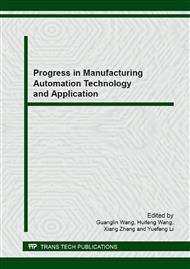p.105
p.113
p.122
p.128
p.133
p.138
p.144
p.148
p.153
Theoretical Research and Simulation of Grit’s Motion for Internal Ultrasonic Vibration Grinding
Abstract:
In order to better reveal the theoretical nature of internal ultrasonic grinding which is an efficient grinding technology, the characteristics of grits motion is analyzed under axial vibration and the grits kinematic equation is established. By using Matlab the single particles trajectory is simulated, then the displacement of a grit is given at any time they contact. Through the theoretical analysis and Matlab simulation, we can achieve that for axial ultrasonic vibration the influences of axial feed on the grits trajectory is too litter to be ignored. So when calculate the contact length of the grinding wheel and the work piece, the grinding wheels axial feed can be neglected. Then the contact length of the grinding wheel and the work piece is achieved. It has a significant value for simplifying the calculation of the grinding force and the analysis of internal ultrasonic grinding.
Info:
Periodical:
Pages:
133-137
Citation:
Online since:
September 2013
Authors:
Keywords:
Price:
Сopyright:
© 2014 Trans Tech Publications Ltd. All Rights Reserved
Share:
Citation:


